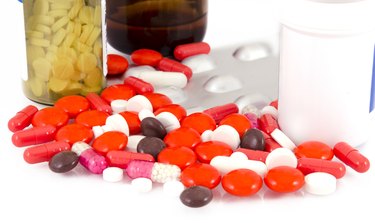
It can be disquieting to see that the vitamin you stocked on your shelf changed color. You may be tempted to throw such vitamins out. However, a color change may or may not signal that your supplement is due to be replaced. Your best bet is to check the expiration date, notes the New York Times. Vitamin content changes also can alter the color of foods.
Considerations
Video of the Day
If you have a vitamin supplement that changes colors, it may mean your vitamin is no good anymore, according to the New York Times. The same goes if your vitamin supplement's physical appearance otherwise changes or if it smells or tastes different. Don't worry if you've consumed an old vitamin, however. It's not dangerous --it's just lost its potency.
Video of the Day
Identification
Color changes don't always mean your vitamins have gone bad, however. Such changes are the result of oxidation. Thus, a vitamin C tablet that is light tan at the time you purchase it may become a bit darker after you open the bottle repeatedly. In general, vitamins are good until their expiration date when properly stored, notes the New York Times. It's best to keep your vitamins in their original containers in a cool, dry place and away from light.
Time Frame
You may see color changes in pressed vitamin tablets before you see them in capsulated or sugar-coated vitamins. That's because the pressed tablets are more porous and thus more vulnerable to oxidation. The other types are fairly well sealed so tend to last longer, according to the New York Times.
Potential
When your foods are exposed to light, oxidation can reduce their vitamin content and fade the foods' color, notes the Canadian Academy, a private international school in Kobe, Japan. For example, the pink color in salmon that is due to carotenoids, or vitamin A, may disappear due to oxidation. However, antioxidant vitamins such as C and E can be used to extend the shelf life of foods because they delay the onset of oxidation or slow its rate.
Expert Insight
Some vitamins in your food can be sensitive to an alkaline pH, and cooking in such an environment can destroy them. When this occurs you will see color changes. For example, carotenoids in carrots and sweet potatoes, which are responsible for these foods' colors, will shift to become more yellow than orange when these foods are placed in boiling water for three minutes or so, according to "Elementary Food Science," by Ernest R. Vieira. To avoid this, add an acid such as vinegar to your cooking water, Vieria advises.
- Vitanet Online: Vitamin C FAQs
- “Elementary Food Science”; Ernest R. Vieira; 1999
- New York Times: “Consumer Saturday—Storing Vitamins from A to K;” February 14, 1981
- “Vitamins: Their Use and Abuse”; Joseph Victor Levy and Paul Bach-y-Rita; 1976
- “Handbook of Food Science, Technology, and Engineering”; Yiu H. Hui; 2006
- Office of Dietary Supplements: Vitamin A and Carotenoids
- Canadian Academy